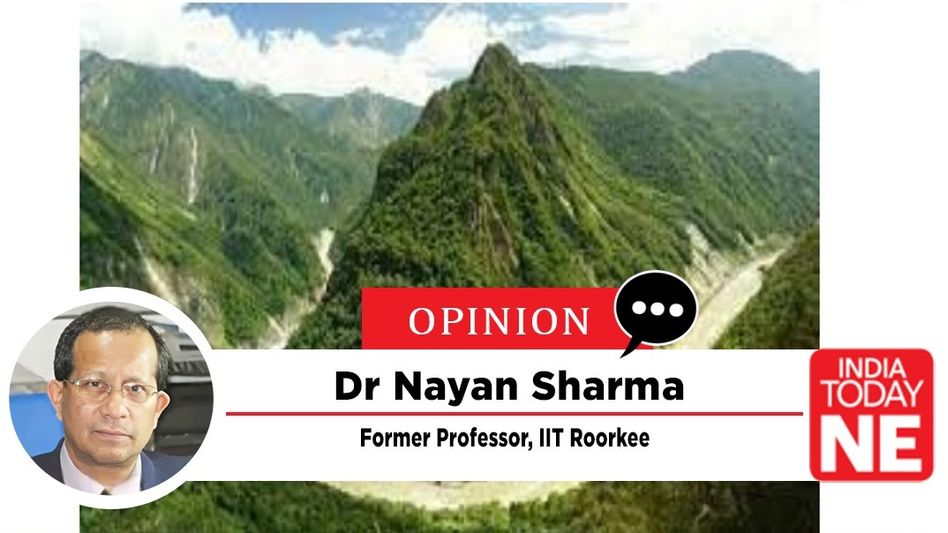
Why China’s mega dam at Yarlung Tsangpo Canyon is a threat to other countries
The Brahmaputra River, vital for over 200 million people in China, India, and Bangladesh, faces severe hydropolitical issues due to the lack of a water-sharing agreement.

The Brahmaputra River is a source of life for more than 200 million people living in China (Tibet), India (North East Region), and Bangladesh. The three stakeholder riparian countries have so far not concluded any water-sharing agreement for the Brahmaputra, other than an MoU for providing high flood data by China from May to October.
The Yarlung Tsangpo Gorge of Great Bend is defined by superlatives. Carved into granitic bedrock, the Gorge reaches more than 5.3 km (17,000 feet) from top to bottom in some places, making it three times deeper than the Colorado River Grand Canyon in the USA. The Yarlung Tsangpo enters the Gorge just downstream of Pe (Tibet), near the settlement of Zhibe. The Canyon has a length of about 240 kilometers as the Gorge bends around Mount Namche Barwa (7,782 meters or 25,531 feet) and cuts its way through the Eastern Himalayas. Its waters drop from about 2,900 meters (9,500 ft) near Pe to about 1,500 meters (4,900 ft) at the end of the Upper Gorge where the Po Tsangpo River joins. The river continues through the Lower Gorge to the Indian border at an elevation of 660 meters (2,170 ft).
In the absence of any River Treaty, the transboundary Brahmaputra River is beset with vexed issues of ‘hydropolitics’ for riparian nations, affecting their economic growth due to vital dependence on the transboundary river. This is especially disconcerting as China has constructed some dams on the transboundary Yarlung Tsangpo, including the 114-meter-high Zangmu Dam near the Bhutan-India border.
Reportedly, China is considering building a ‘Super’ Mega Dam on the Yarlung Tsangpo quite close to the Indian border at Medog County. This massive project aims to tactically exploit the huge elevation drop of over 2 km over a stretch length of just 50 km in the intensely precipitous gradient of the Great Bend dipping sharply towards the Indian border.
The mega dam project will generate a colossal 60,000 MW of hydropower. This will be about three times that of the Three Gorges Dam on the Yangtse river, which is currently the highest in the world. It is reported that in pursuit of this aim, the state-owned hydropower company POWERCHINA signed a strategic cooperation agreement with the Tibet Autonomous Region (TAR) government to implement hydropower exploitation in the downstream leg of the Yarlung Zangbo river as part of the new Five-Year Plan (2021-2025).
It is a matter of great concern for the downstream riparian countries, as the ‘Super’ mega dam is reportedly being proposed in a geologically unstable region with very high seismicity, as evidenced by several recent earthquakes. For instance, twin earthquakes on the Yigong-Tsangpo tributary of the Yarlung Tsangpo in the year 2000 triggered massive landslides, causing devastating floods with loss of lives in Arunachal Pradesh and Assam. Another earthquake struck in 2017 near the Great Bend Canyon, triggering sizable mountain slides and giving rise to two highly risk-prone unstable temporary lakes.
For the safety of downstream riparian areas, any dam project proposition should be analyzed by a trustworthy Dam Break Simulation Study using relevant river data from the downstream region to envision the likely inundation and devastation in the event of unforeseen dam failure.
No such Dam Break Analysis is being done for the proposed ‘Super’ Mega Dam on the transboundary river Yarlung Tsangpo. The necessary downstream hydrographic and hydrological river data available with Indian and Bangladeshi authorities are apparently not being sought by China, which is reportedly pursuing the project unilaterally without the involvement of the two major stakeholder downstream riparian nations - India and Bangladesh.
In the event of the unforeseen failure of the colossal dam perched at such a perilous height of over two km above the densely populated narrow Brahmaputra plains, a highly frightful and inconceivable disaster, inflicting hundreds of thousands of human casualties with attendant catastrophic devastations, would befall not only India but also Bangladesh.

Besides the looming dam break threat from such a height, the absence of any River Treaty among the three major riparian nations would allow China to gain full control over the Brahmaputra streamflow entering downstream riparian areas in India and Bangladesh. China has built all-weather highways linking Nyingchi city in Eastern Tibet with Medog County (the dam site), apparently to build the ‘Super’ Mega Dam and presumably with tunnels for probable water diversion.
As an upper riparian, China’s intent to divert the Brahmaputra water to arid parts of northern China has remained a point of concern. Such a diversion would reduce non-monsoon stream flow, causing the Brahmaputra to dry up in the lean season with grave morphological effects. Conversely, whenever China releases surplus water from the Super Mega Dam during monsoons, sudden gushes of flash floods could inundate riverine areas in India and Bangladesh.
In response to the above Super Mega Dam, India has announced plans to build its own dam at Yingkiong in Arunachal Pradesh to offset the adverse impact of the Chinese dam by flood moderation and to produce 10 Gigawatts in the Upper Siang multi-purpose storage project.
The way forward could be either to endure the current state of unilateral management of the transboundary river or to proactively explore initiating a process for a joint transboundary framework based on a mutual benefit-sharing approach among the three major riparian countries.
A benefit-sharing approach seems desirable to balance the mounting climate change effects, glacier melt, snow cover loss, and unpredictable hydrological behavior such as cloud bursts, earthquakes, and landslides impacting China, India, and Bangladesh. The riparian countries of China, India, and Bangladesh should collectively manage the invaluable but depleting freshwater reserves in the form of snow cover in the Hindu Kush Himalayas - all in their enlightened self-interest. Glacier retreat with snow cover loss in the Himalayas is not in the interest of all four riparian countries, as it would ultimately deplete the freshwater reserve.
A sustained proactive diplomatic effort is needed to better manage the transboundary Brahmaputra waters. The way forward could involve a focused diplomatic policy to commence with readily acceptable matters, moving towards resolving more vexed issues.
To start with, it may be practical to diplomatically and technically find areas of probable agreement. The working principle could involve the following preliminary exercises:
1. Harnessing the collective know-how of the two big Asian nations, in concert with the enterprise of other two riparians, Bangladesh and Bhutan, to arrest glacier melting and snow cover loss in the Himalayas for conserving depleting freshwater reserves and preventing glacier retreat.
2. Cooperatively developing the hydropower potential of the Yarlung Tsangpo, including the Great Bend Canyon, by deploying medium to low-height dams equipped with adaptive technologies like Piano Key Weir/Fuse Devices in cascades to address environmental, ecological, and dam safety concerns. This would also promote local consumption of the huge power block in the South Asian region, cutting down significant power transmission losses.
3. Innovating out-of-the-box technologies to mitigate devastating cloud burst floods, erosion, and landslides in the Yarlung Tsangpo/Brahmaputra regions of Eastern Tibet, China, India, and Bangladesh through joint technical cooperation using versatile state-of-the-art technology.
ALSO READ | Does China want to build big dams on Brahmaputra to keep India in its place?
Copyright©2025 Living Media India Limited. For reprint rights: Syndications Today









